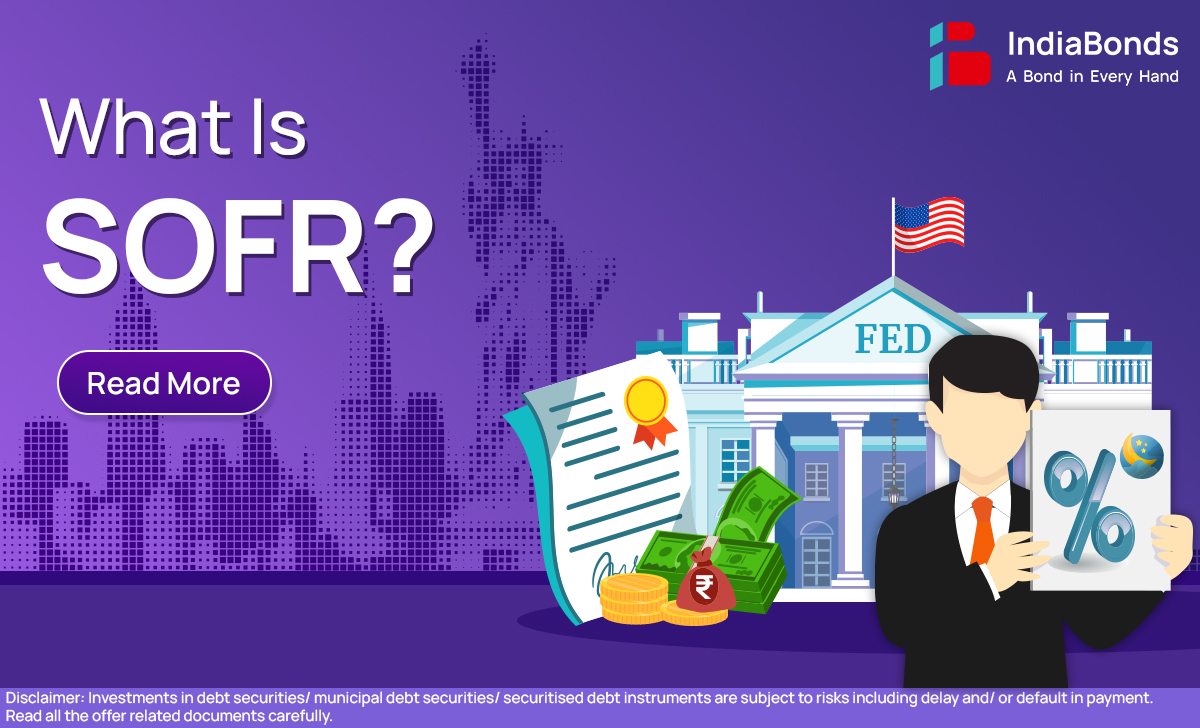What is SOFR?

Picture the world of big money – loans, investments, all that jazz. For ages, there was this go-to number called LIBOR, the London Interbank Offered Rate. It was the yardstick for figuring out interest rates on tons of stuff. But, things change, right? People started wanting something a bit more transparent, something that really showed what was happening in the markets. That’s where the Secured Overnight Financing Rate, or SOFR, stepped into the spotlight. Now, it’s the main game in town, setting the pace for trillions of dollars. Whether you’re an investor keeping an eye on things, a company borrowing cash, or just curious about how the global financial machine works – and hey, it even has a little ripple effect here in India – understanding SOFR is pretty crucial.
Think of SOFR as the daily price tag for borrowing U.S. dollars overnight. It’s like a benchmark, a reference point. The cool thing about it is that it’s not just some made-up number. The Federal Reserve Bank of New York keeps tabs on actual transactions – specifically, loans that are backed by super safe U.S. Treasury bonds – and that’s what SOFR is based on.
Now, the old LIBOR? That was more of an estimate, a bunch of banks giving their best guess. SOFR, on the other hand, is rooted in real, live deals. That makes it way more reliable and practically risk-free because these loans have top-notch government bonds as security. So, credit risk? Barely there. Because of this solid foundation, SOFR has become the go-to rate for all sorts of things, like loans where the interest rate can change, those complicated financial things called derivatives, and even bundled-up loans known as securitized products.
Okay, so why should we even care about a change in this overnight rate? Well, SOFR basically sets the tone for how much it costs to borrow money in the short term. Even tiny shifts can have a domino effect across a whole bunch of financial tools.
Let’s break it down:
When SOFR goes up:
Suddenly, loans get pricier. This hits everyone from regular folks with mortgages to big businesses taking out loans.
If you’ve got investments with floating interest rates, you might see a bit more cash coming your way.
The financial system might feel a bit tighter, which can actually help keep inflation in check.




Now, when SOFR dips:
Borrowing becomes cheaper, which can encourage people and companies to spend and invest more.
Investors often start looking at riskier options, hoping for better returns since the safer stuff isn’t paying as much.
Generally, bond prices tend to rise because the yields on new bonds coming out are lower. Now, you might be thinking, “Hey, this is all happening in the U.S. What’s it got to do with us in India?” Good question! Even though SOFR isn’t our local benchmark like MIBOR or the RBI’s repo rate, it still plays a part. Lots of Indian companies actually borrow money from overseas using things linked to SOFR. So, if SOFR wobbles, it can change how much it costs them to protect themselves against currency swings (that’s hedging), the overall cost of their foreign debt, and even nudge the yields on bonds we have here in rupees. It’s like a global financial connection – what happens with SOFR can send little waves all the way to our shores.
Let’s paint a picture of how this works. Imagine a company in the U.S. borrows $100 million, and the interest they pay is SOFR plus an extra 2%. Now, say on January 1st, SOFR is at 5.30%. Their total interest rate for that period would be:
5.30% (SOFR)+2.00% (spread)=7.30%
So, in simple terms:
| Date | SOFR Rate | Spread | Final Rate | Annual Interest on $100M |
| Jan 1 | 5.30% | 2.00% | 7.30% | $7.3 million |
| Mar 1 | 5.50% | 2.00% | 7.50% | $7.5 million |
| Jun 1 | 5.20% | 2.00% | 7.20% | $7.2 million |
Similarly, banks might issue bonds where the interest rate changes based on something called “term SOFR” (which looks at SOFR over a set period like 1, 3, 6, or 12 months). The interest they pay (the coupon) adjusts based on the average SOFR during that time, plus a bit extra. This way, the price of borrowing and investing stays in sync with what’s actually happening in the market, making things more transparent and, well, honest.
So, how do they actually figure out this SOFR number every day? It all comes down to real overnight borrowing between big financial players using U.S. Treasury securities as collateral. These deals happen in what are called the tri-party repo and GCF repo markets.
Every single business day, the folks at the New York Fed crunch the numbers from all these transactions and come up with a volume-weighted median rate. Think of it like finding the middle point, but also taking into account how much money was involved at each rate. This makes sure SOFR truly reflects the market’s heartbeat, not just some guesswork. That’s why it’s seen as so trustworthy and less likely to be messed with.
Basically, SOFR tells us what big institutions have to pay to borrow cash overnight using super safe, government-backed stuff. Now, the old LIBOR? It used to factor in the risk that the borrower might not pay back. But SOFR? It’s practically risk-free.
You’ll see SOFR pop up around 8 a.m. Eastern Time every business day. Big players all over the world use it to set the interest rates on loans that can change, to price those complex derivatives, and to create all sorts of interest-related financial products. Because it reacts to how much cash is floating around in the market, it stays pretty accurate and reliable.
Even though SOFR is a U.S. thing, it can definitely send ripples into our Indian markets, especially when things get a bit shaky globally. For example, if SOFR suddenly shoots up, investors worldwide might decide to pull their money out of places like Indian stocks and put it into the U.S. where returns look better.
Also, those Indian companies that borrow in foreign currencies (it’s called External Commercial Borrowings or ECBs) and have their interest rates linked to SOFR? Well, their borrowing costs could go up. This can squeeze their profits and make it harder for them to pay back their debts. It’s all connected – what happens with SOFR can echo across the global financial landscape, and India is part of that echo. You might also hear about something called the 90-Day Average SOFR. This is just a way to smooth out the daily ups and downs of SOFR by looking at the average over the last 90 days. As of April 9, 2025 (that’s in U.S. time), it was around 4.35670%. This average is often used for things like derivatives or longer-term loans to make the interest rates a bit more stable and predictable.
A little history lesson: SOFR was born in April 2018 as part of a big move away from LIBOR. There were worries about how LIBOR was being set and the fact that there weren’t as many actual transactions happening between banks anymore. A group called the ARRC (Alternative Reference Rates Committee) and the Federal Reserve were in charge of this switch.
LIBOR officially said goodbye in 2023, making SOFR the main benchmark for U.S. dollar deals. Knowing how this change happened helps us understand why current financial products are structured and priced the way they are. So, to wrap it up, SOFR isn’t just another number. It’s a fundamental shift in how we set interest rate benchmarks around the world. It’s built on real-life trades, backed by super safe government bonds, and offers a level of trust that the old system just couldn’t match anymore. Whether you’re dealing with investments that have changing interest rates, managing international loans, or just trying to stay in the know, understanding SOFR and how it works can give you a real advantage in today’s interconnected financial world.
FAQs
1. What rate is SOFR today?
SOFR is published daily by the New York Fed. You can check the most recent SOFR rate today on nyfed.org.
2. What is SOFR vs LIBOR?
SOFR is based on real transactions in the repo market backed by Treasuries, making it more transparent. LIBOR was based on estimates from a panel of banks.
3. Who uses SOFR rate?
SOFR is widely used in the pricing of U.S. dollar-denominated loans, bonds, and derivatives. It’s also adopted in cross-border deals by Indian corporates and institutions.
4. What is the concept of SOFR?
SOFR reflects the cost of overnight secured borrowing and acts as a nearly risk-free benchmark interest rate.
5. How to calculate SOFR?
SOFR is calculated using the volume-weighted median of overnight repo transactions secured by U.S. Treasuries.
Disclaimer : Investments in debt securities/ municipal debt securities/ securitised debt instruments are subject to risks including delay and/ or default in payment. Read all the offer related documents carefully.



















































